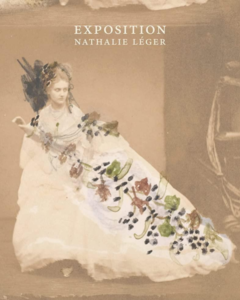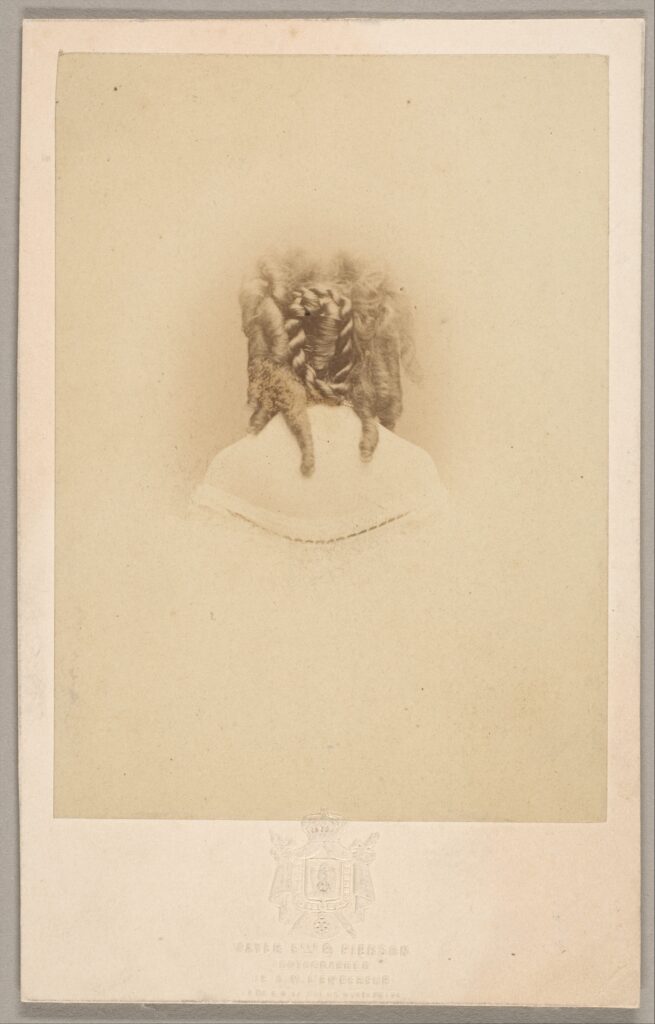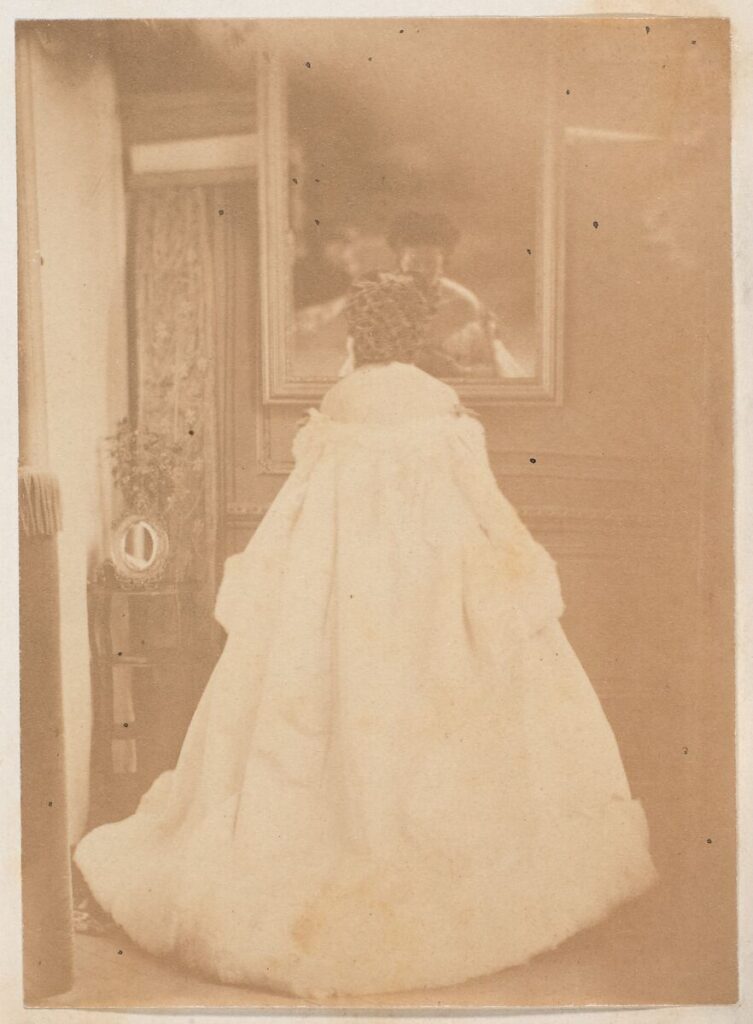This essay was first made available last month, exclusively for our Patreon supporters. If you want to support Full Stop’s original literary criticism, please consider becoming a Patreon supporter.

Midway through Exposition, the first volume of Nathalie Léger’s trio of feminist biographies, the author-narrator recalls a poignant memory from her girlhood. “[T]o keep herself from being forgotten,” her father’s mistress (whom Léger and her mother refer to as “l’autre,” the other) had rented a house directly across from the one in which Léger lived with her parents. One afternoon, peeping through the thin hedgerow that separates the two, Nathalie catches her father taking risqué photographs of his lover on the veranda, using a camera that her mother had recently given him for his birthday. “That wasn’t at all how we took photographs at home,” she remembers: “My father took a full-body shot of the family and a portrait of my mother (seated, her hands pulled back in an elegant and faint-hearted gesture at the collar of her sweater; seated, at a diagonal, on some stone edging, her gaze far out over the distance; profil perdu, before a sorry landscape).” Eventually, the mistress has removed all of her garments and the father scoops her nude body off the railing. Before they disappear inside, though, she “took the camera from his hand, quickly wound it and, her arms around my father’s neck, body clinging to him, she aimed over his shoulder, as if she were photographing the empty terrace behind him.” It is only in retrospect that she realizes her surveillance has not gone unnoticed: “Some days later, I found a photo had been propped up on my nightstand while I slept. You see only my face, a very small face emerging from a hole in the foliage.”
The daughter bearing witness to the father’s adultery is a footnote to the main point of this vignette, which ultimately has to do with how the act of scrutiny implicates the spectator in the scene. It is hard to fathom this literally central moment outside the framework of anagnorisis—the flash of recognition that transforms ignorance into knowledge. Speaking about Léger’s text in terms of Aristotelian poetics feels malapropos, given its aversion to generic conventions like plot, but the epiphanic significance of this episode, both within and beyond the narrative, is crucial to it. The voyeuse is made to observe herself from the perspective of the object of her gaze; the shift in viewpoint results in her inclusion in the depth of field—a literal exposure—but it does not produce a figurative illumination of her interiority: “I’m staring at the lens, but you don’t see anything, nothing of what I see, nothing of what I’m thinking.” The photograph captures the author-narrator coming into full consciousness of her father’s affair, but even more significant is her subsequent awareness regarding the openness of this secret: She knows that he knows that she knows. Meta-textually, as well, this moment clarifies the nature of Léger’s true protagonist, which is the very complexity and slipperiness of the relationship between the author-narrator and her subject. Whose story, after all, is being told? And to what degree can a story, no matter the scope of its aperture, see clearly?
In her iconic meditation on personal narrative, The Situation and the Story, published in 2001, Vivian Gornick ponders the displacement of the novel by memoir. Thirty years earlier, she claims, “people who thought they had a story to tell sat down to write a novel,” but that is no longer the default:
everywhere—among those who read and those who write—people are asking, Why memoir? And why now? What has happened over the past decades to account for the vivid shift in interest, from one genre to another, that is overtaking the common impulse, alive at all times, to shape one’s experience through writing?
To the contemporary reader, barely twenty years in the future, Gornick’s tidy distinction between novel and memoir feels almost quaint. The rise of autofiction has blurred the line between them, which persists at best as a fuzzy horizon against which Léger’s project shimmers like a mirage. What, exactly, is it? Critics have had notorious difficulty classifying what Léger herself calls a “triptych”—invoking the tripartite panel paintings that were traditionally commissioned as altarpieces—precisely because it participates in a larger effort to dismantle our collective worship of genre. In her essay “Plagiarism,” Kate Zambreno uses the term “book,” to which it seems etymologically fitting to add the suffix “-let,” given that the colloquial French equivalent for book, bouquin, comes from the Middle Dutch diminutive boeckin (little book). Another term might be para-biography: the telling of another’s story in order to understand one’s own.

The US editions of Exposition, Suite for Barbara Loden, and The White Dress—originally published in Paris between 2008 and 2018 but only translated into English in 2019, 2015, and 2020, respectively—were beautifully released as slim paperbacks by the Dorothy Project in 2016 and 2020. The ample margins that characterize editor Danielle Dutton’s elegant formatting complement Léger’s thematic fascination with the plenitude of our desire for what escapes us. One way of describing all three texts is by comparing them to profil perdu: the literary equivalent of this elusive form of portraiture, which refuses to reciprocate the beholder’s gaze. Instead of eye contact or a complete face, the profil perdu offers the viewer a nape, an earlobe, a curve of nostril, a glimpse of chin. Similarly, Léger denies the reader a frontal view of her subject(s), which is—in every booklet of the triptych—consistently, even aggressively, manqué. At a January 2020 “visual lecture” entitled “Itinerant Women” at the Triangle Arts Center in New York City, during which she discussed Suite for Barbara Loden and The White Dress, Léger herself reportedly addressed this phenomenon directly, confiding to her audience that, “I wrote about these women because I did not know how to write about my mother.”
While Gornick argues that a good memoir hinges on a tight grasp of its subject—“what is it about? This is the story”—Léger suggests that it is precisely the refusal to conform to the conventions of story that makes a subject compelling, or even a subject at all:
For years, I had thought that to write you needed, at the very least, to master your subject. Many reviewers, famous writers, and critics have said that to write you have to know what you want to say. They repeat, hammering it home: you have to have something to say, about the world, about existence, about, about, about. I didn’t know then that the subject is precisely what masters you.
If we accept her premise that the subject is a kind of possession, it makes sense to think of the form that can accommodate it in terms of exorcism—interested more in the manifestation of absence or eviction than in positive presence. But this, Léger reminds us, is what literature is always up to, if it is doing its job. Like photography, “literature obstinately gropes for” what pioneering nineteenth-century photographer Nadar called the “impalpable specter.”
As Leslie Jamison and Eula Biss have pointed out, the manic energy that Léger brings to her pursuit of the phantoms of Virginia Oldoïni (the Countess of Castiglione), Barbara Loden, and Pippa Bacca is unimaginable without her deep—not to say pathological—avoidance of the primordial ghosting that underpins them: her father’s abandonment of his family and the trauma it inflicted. The voraciousness of Léger’s commitment to telling these dead women’s tales is nourished by her inability to tell her own, or her mother’s (except by proxy, and then only barely). Léger’s work is part of a larger trend that seeks to dissolve the boundary between lived and vicarious experience, unsettling the consensus around what distinguishes fiction from non-fiction. Léger’s mother makes the familiar tension between the two explicit in the third volume of the triptych, pitting their two “subjects” (the mother’s divorce, on the one hand, and Léger’s book about Italian performance artist Pippa Bacca, on the other) against one another:
mine is more real than yours, mine, you lived through it too, you’ve got evidence, I mean memories, whereas you have no experience of your subject, the fact that it really happened doesn’t change anything you didn’t live it so it’s just fiction, your subject is no more than wishful thinking.
The ambition of Léger’s series—shared by texts like Zambreno’s Heroines, Doireann Ní Ghríofa’s A Ghost in the Throat, Lisa Robertson’s The Baudelaire Fractal, Shola von Rheinhold’s Lote, Martha Sprackland’s Citadel, Jessie Greengrass’s Sight,and Laura Smith’s The Art of Vanishing, among others—is to show that drawing such an ontological distinction between the author’s empirical reality and her representation of the subject’s is arbitrary at best; in some metaphysical but fundamental sense, both owe their existence to one another. The randomness of the encounter between them is part of this mutual debt, and it is characteristic of the subject that it arrives by accident: “[The subject’s]. . . appearance is trivial, a word or phrase overheard in chance meetings,” Léger writes. She provides this account of her initial rendezvous with the Countess of Castiglione: “It was by coincidence, at the top of a small wooden staircase in the dilapidated bookshop of a provincial town, that I came across her.” At the same time, certain aspects of this coincidence are pre-ordained: “on the winding path of femininity, the loose stone you stumble over is another woman.” Gynocentrism seems to be a dominant trait of para-biography at this stage of its generic evolution.
The question of what counts as “real” is one that not even the archive can sufficiently resolve. Léger’s work forges a fresh relationship to primary sources, one based less on recuperating lost voices or amplifying silences in the historical record than on acknowledging the limitations and disappointments of archival traces, however abundant. All of Léger’s subjects left behind rich material legacies. The Countess of Castiglione was the most photographed woman of the nineteenth century, bequeathing almost five hundred photos to posterity; Loden produced a substantial body of her own work in cinema as an actress and director and, as the wife and frequent collaborator of Elia Kazan, influenced his better-known oeuvre as well; Bacca made video recordings of all of her work (although her final journey was taped over by her murderer a few days after her death). Still, the arduous labor of making themselves available to future generations is not what Léger finds most generative to her own project. In a subterranean room at the Hôtel Drouot, where portions of Robert de Montesquiou’s estate will soon be auctioned, Léger sifts listlessly through his vast collection of Oldoïni’s photographs:
I regard the images silently. They are drab. I pretend to stare at them with interest, but disillusion wins out. . . . I had imagined them gleaming, alive, revelatory of a presence, all I have in my hands are mediocre prints . . . in exhausting abundance: this overexposed body, this stubborn refusal to ever be satisfied with herself, this obstinacy to always return to herself, to this small slice of face, to these postures. . .
Whatever “radiance” inheres in these subjects, it is not to be found in the tangible artifacts they bequeathed to posterity. Indeed, their vitality is diminished by these “proofs of life”: they are most vivid and dynamic in the ways in which they remain opaque to and estranged from the contemporary researcher.
Léger’s identification with her subjects is defined by obliquity. Loden seems to have felt no such ambivalence for the eponymous heroine of the only film she wrote and directed, Wanda, which follows a young Appalachian divorcée as she drifts aimlessly through her own life against the backdrop of Pennsylvania coal country. Loden later claimed that she never considered casting anyone else in the role: “I was the best for it.” Léger’s kinship with her central figures is more diffuse and elliptical: “I look at these women. They leave, they move into the unknown. I follow them. . . . I am alternatively like Wanda, like Pippa, like everyone who confronts the world: without any knowledge, and yet, charged with intentions. I leave, I move into the unknown. . . . I consult, I extract, I deduct, I get lost, I go back, I diverge. I need to know everything about the history of hair-curlers.” Léger is blunt about the way in which the abyssal nature of obsession, constitutionally incapable of attaining its object, simultaneously fuels and obstructs the wish for mimetic coherence.

Grammatically speaking, the oblique case refers to a non-nominative nominal— a noun or pronoun that occupies any part in a sentence except the subject. If Léger’s mother functions this way throughout the triptych, so, too, do the women around whom each volume supposedly revolves. The formal obliquity of Léger’s work inheres mainly in its departure from her putative subject’s elective form of self-representation–which is in every case spectacular (photography, film, performance art)—toward narrative language. For example, Léger wants to represent the Countess “outside of her endless image,” but much of her attempt to do so consists of ekphrasis. The substitution of words for images is in itself a torquing or declension of the primary (visual) source. Splicing one’s twenty-first-century world with that of a historical figure is a multi-faceted labor of translation–not only across time, but across media, languages, and cultures. Para-biography is the elliptical art of perceiving and reconstructing these otherwise invisible and inarticulable ancestral links.
Unlike Gornick, who believes that memoir is an act of self-disclosure—one that sets out to reveal the “authentic I”—Léger pioneers a new variation of personal narrative that conceals its first-person motives, to some extent, even from itself. At one point, the author-narrator asks, without a hint of facetiousness, “What am I trying to talk about?” That the triptych ends up being, in some circuitous way, about Léger and her mother ultimately feels both totally inevitable and completely unintentional, in keeping with the (anti-)methodological statement in the very first paragraph of Exposition: “Surrender, premeditate nothing, want nothing, neither discern nor dissect nor stare, but rather shift, dodge, lose focus, and—slowing down—consider the only material that presents itself, as it presents itself, in its disorder and even in its order.” The adjectival form of “exposition,” which derives from the Latin root exponere (to put forth), refers to a style of prose whose subject is decidedly unambiguous. Expository writing is clear and informative: It presents facts, analyzes evidence, and argues a thesis. Léger’s title—which ostensibly evokes the 1867 Exposition Universelle in Paris, where Pierre-Louis Pierson’s photograph of Oldoïni dressed as the Queen of Hearts was on display—plays on this rhetorical style, which is anathema to her preoccupation with the audacity of storytelling:
It is so difficult to tell a story, to begin with a beginning, to finish with an ending, to not get bogged down in details, in minor incidents, to skim over the events, pointing to them rapidly like Nadar in his balloon looking down over the city, taking in everything, all at once, but from a distance—
Léger constructs a story out of precisely what traditional biographers would dismiss or overlook—the minutiae that they would consider superfluous or obstructive to the chief aims of narrative progression, continuity, and shape. Of the Countess of Castiglione, she says, “I would gladly reduce this woman’s life to her sittings at the photographer’s”—precisely the trivia that official accounts of her life mention only in passing.
For Léger, however, stillness and aporia are sites of action. Of the three sisters of fate in Greek mythology who are said to weave each individual life, she is most interested in the eldest, who finally snips the thread, whom Exposition ends by invoking: “the third one was called Atropos: the Inevitable.” The last photograph that Léger describes is not of Oldoïni, but of Léger’s mother as a small child, once again in profil perdu:
Three young girls photographed from behind, side by side in the water, which reaches their thighs. My mother is one of them, but which? . . . Three young girls from behind, one diving, one peering into the water, the third upright, immobile. The diver, the seeker, or the dreamer? The one who throws herself with a splash, the one who observes and inquires, or the one who gazes into the distance thinking of nothing? She could be any of the three. She has probably been all of them, the joyous one, the scrupulous one, the pensive one. But I keep looking anyway.
It is in the subject’s stasis—atropos literally means “not turning”—that all of her possibilities can thrive. The immediacy of a face-to-face encounter would extinguish them, and it is this paradox that animates Léger’s triptych, which is emblematic of a broader trend intensely devoted, in the end, to Gornick’s core thesis: Universal stories can only ever be grounded in particular situations. Para-biography seeks to express what we might now call the author-narrator’s own “truth”—what Gornick calls “the insight, the wisdom, the thing one has come to say”—through circumstances that were, according to modern western notions of selfhood, unique to someone else. Its “I” encompasses the lyric and the autobiographical and opens up exhilarating new prospects for the field of life writing.
Elizabeth Brogden is a writer and editor based in Cambridge, MA. She can be found online at www.golightlyeditorial.com.
This post may contain affiliate links.







